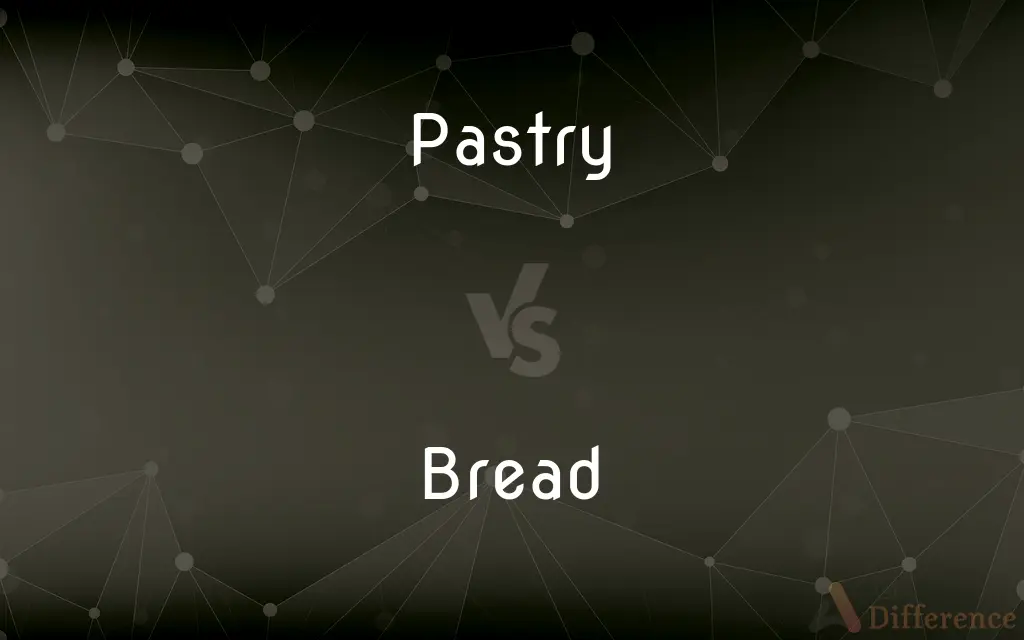Pastry vs. Bread — What's the Difference?
By Maham Liaqat & Fiza Rafique — Updated on March 24, 2024
Pastry is typically rich in fat, making it flaky and tender, while bread is leaner, often yeast-leavened, and has a more robust structure.

Difference Between Pastry and Bread
Table of Contents
ADVERTISEMENT
Key Differences
Pastry, known for its buttery and flaky texture, often includes ingredients like flour, water, butter, and sometimes sugar, which contribute to its tender and rich qualities. Bread, on the other hand, is primarily made from flour, water, and yeast, leading to a more elastic and chewy texture due to gluten development.
The making of pastry involves a technique of layering dough and fat to create air pockets that puff up during baking, resulting in a light and airy structure. Whereas, bread making involves kneading the dough to develop gluten strands, which gives bread its characteristic chewy texture and volume.
Pastries are often associated with sweet and decadent desserts or breakfast items, such as croissants and tarts, incorporating various fillings and flavors. Bread, however, is a staple food in many cultures, ranging from simple loaves to complex flavored varieties like sourdough or rye, serving as a base for meals or as accompaniments.
The baking process for pastries requires precise temperature control to ensure the fat in the dough remains solid until baking, preventing the layers from merging. Bread baking is more forgiving in terms of temperature but requires proper yeast fermentation to achieve the desired rise and flavor.
Pastry is typically consumed as a treat or dessert due to its rich content and sweet variations, while bread is a versatile component of daily meals, capable of complementing a wide range of dishes and cuisines.
ADVERTISEMENT
Comparison Chart
Main Ingredients
Flour, water, high fat content (butter, shortening)
Flour, water, sometimes yeast, with minimal to no fat
Texture
Flaky, tender, and light
Chewy, elastic, with a more substantial structure
Common Types
Croissants, tarts, pies
Sourdough, baguette, whole wheat
Preparation
Layering dough with fat
Kneading to develop gluten
Usage
Desserts, sweet or savory treats
Staple food, meal base, or accompaniment
Baking Process
Requires precise temperature to maintain fat layers
Focuses on yeast fermentation and gluten structure
Cultural Significance
Often considered a luxury or treat
A daily staple in many cultures worldwide
Compare with Definitions
Pastry
A dough made from flour, water, and fat, used for making desserts and baked goods.
She rolled out the pastry to prepare apple pies for the bakery.
Bread
A staple food prepared from a dough of flour and water, usually baked.
She baked fresh bread every morning for her family.
Pastry
Characterized by its flaky and tender texture, achieved through layering.
The pastry's flakiness was perfect, thanks to the cold butter.
Bread
Comes in various forms, from simple loaves to complex flavored artisanal varieties.
The bakery offered a range of bread, from sourdough to multigrain.
Pastry
Served often as a luxury or special occasion food due to its rich content.
For the holiday brunch, they served a variety of gourmet pastries.
Bread
Can be leavened by yeast or chemical agents, contributing to its rise and texture.
The yeast bread rose beautifully, doubling in size before baking.
Pastry
Requires careful handling to prevent the fat from melting before baking.
He chilled the pastry dough to maintain its layered structure.
Bread
Known for its elastic and chewy texture, resulting from gluten development.
The bread's chewy texture was ideal for making robust sandwiches.
Pastry
Commonly associated with sweet treats, although it can be savory.
The savory pastry was filled with spinach and feta cheese.
Bread
Integral to meals across different cultures, serving multiple culinary roles.
For dinner, they served a rustic bread alongside the soup.
Pastry
Pastry is a dough of flour, water and shortening (solid fats, including butter or lard) that may be savoury or sweetened. Sweetened pastries are often described as bakers' confectionery.
Bread
Bread is a staple food prepared from a dough of flour and water, usually by baking. Throughout recorded history, it has been a prominent food in large parts of the world.
Pastry
Dough or paste consisting primarily of shortening or another fatty substance mixed with flour and water, often baked and used as a crust for sweet foods such as pies and tarts.
Bread
A staple food made from flour or meal mixed with other dry and liquid ingredients, usually combined with a leavening agent, and kneaded, shaped into loaves, and baked.
Pastry
Baked sweet foods made with pastry
Viennese pastry.
Bread
Food in general, regarded as necessary for sustaining life
"If bread is the first necessity of life, recreation is a close second" (Edward Bellamy).
Pastry
One of these baked foods.
Bread
Something that nourishes; sustenance
"My bread shall be the anguish of my mind" (Edmund Spenser).
Pastry
(Informal) A sweet baked good.
Bread
Means of support; livelihood
Earn one's bread.
Pastry
(countable) A baked food item made from flour and fat pastes such as pie crust; also tarts, bear claws, napoleons, puff pastries, etc.
That pastry shop sells not just pastries, but all kinds of baked goods.
Bread
(Slang) Money.
Pastry
(uncountable) The food group formed by the various kinds of pastries.
That pastry shop sells not just pastry, but all kinds of baked goods.
Bread
To coat with bread crumbs, as before cooking
Breaded the fish fillets.
Pastry
(uncountable) The type of light flour-based dough used in pastries.
Bread
(uncountable)
Pastry
A place where pastry is made.
Bread
A foodstuff made by baking dough made from cereals.
We made sandwiches with the bread we bought from the bakery.
Any leftover bread can be put into the pudding.
Pastry
(uncountable) The act or art of making pastry.
He learned pastry from the great Gaston Lenôtre.
Bread
Food; sustenance; support of life, in general.
Pastry
Desserts of all kinds, whether or not these incorporate the baked item made from flour and fat, or that section of a kitchen that prepares these.
I used to work in the fish section, but now I've been moved to pastry.
Bread
(countable) Any variety of bread.
Pastry
The place where pastry is made.
Bread
Money.
Pastry
Articles of food made of paste, or having a crust made of paste, as pies, tarts, etc.
Bread
Breadth.
Pastry
A dough of flour and water and shortening
Bread
A piece of embroidery; a braid.
Pastry
Any of various baked foods made of dough or batter
Bread
(transitive) To coat with breadcrumbs.
Breaded fish
Bread
To make broad; spread.
Bread
(transitive) To form in meshes; net.
Bread
To spread.
Bread
To cover with bread crumbs, preparatory to cooking; as, breaded cutlets.
Bread
An article of food made from flour or meal by moistening, kneading, and baking.
Bread
Food; sustenance; support of life, in general.
Give us this day our daily bread.
Bread
Food made from dough of flour or meal and usually raised with yeast or baking powder and then baked
Bread
Informal terms for money
Bread
Cover with bread crumbs;
Bread the pork chops before frying them
Common Curiosities
How does the texture of bread differ from pastry?
Bread has a chewy and more substantial texture due to gluten development, while pastry is lighter and flakier because of fat layers.
Why is temperature control important in baking pastry?
Temperature control is vital in pastry baking to keep the fat solid until baking, ensuring the layers remain distinct and create a flaky texture.
What defines pastry?
Pastry is defined by its high-fat content, flaky texture, and often sweet or savory fillings, used mainly for desserts and special treats.
Can pastry be savory?
Yes, pastry can be savory, with fillings like cheese, meat, or vegetables, in addition to sweet varieties.
What role does yeast play in bread making?
Yeast is crucial in bread making for fermentation, which helps the dough rise and develops flavor and texture.
How does bread complement meals?
Bread complements meals by serving as a base or side, capable of absorbing flavors and adding texture.
How does the fat content in pastry affect its texture?
The high fat content in pastry makes it tender and flaky, as the fat creates layers that puff up during baking.
Is bread considered a dessert?
Bread is generally not considered a dessert but a staple food, though sweet bread varieties exist.
What makes artisanal bread different?
Artisanal bread is characterized by handcrafted techniques, natural fermentation, and often unique, high-quality ingredients.
Are pastries always baked?
Most pastries are baked, but some, like chilled cream-filled pastries, may involve no-bake components.
Are there gluten-free options for bread and pastry?
Yes, there are gluten-free options for both bread and pastry, using alternative flours and ingredients to accommodate dietary restrictions.
How does kneading affect bread dough?
Kneading bread dough develops gluten strands, giving bread its structure and elasticity.
Can bread and pastry dough be prepared in advance?
Both bread and pastry dough can be prepared in advance, with pastry dough often requiring refrigeration to maintain its fat structure.
What are some common pastry types?
Common pastry types include croissants, pies, tarts, and puff pastries, varying in ingredients and preparation techniques.
Why might someone choose pastry over bread, or vice versa?
The choice between pastry and bread might depend on the occasion, meal type, and personal preference for texture, richness, and flavor.
Share Your Discovery

Previous Comparison
Absolute Monarchy vs. Monarchy
Next Comparison
Mongoose vs. CivetAuthor Spotlight
Written by
Maham LiaqatCo-written by
Fiza RafiqueFiza Rafique is a skilled content writer at AskDifference.com, where she meticulously refines and enhances written pieces. Drawing from her vast editorial expertise, Fiza ensures clarity, accuracy, and precision in every article. Passionate about language, she continually seeks to elevate the quality of content for readers worldwide.














































